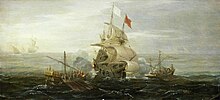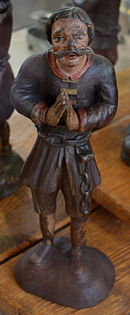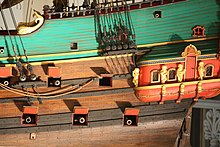Wapen of Hamburg (1669)

|
||
|---|---|---|
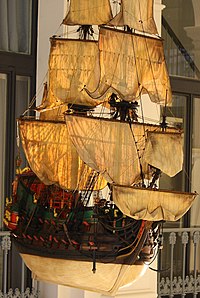 Model of the Wapen of Hamburg (I). It is based on a modern reconstruction. |
||
| Ship data | ||
| Surname: | (The) Wapen of Hamburg (I) | |
| Builder: | Shipyard at Theerhof , Hamburg | |
| Launching ( ship christening ): | 1669 | |
| Crew: | 150-250 officers and crew grades | |
| Technical specifications | ||
| Type: | Convoy ship , two-decker | |
| Length: | 40 m | |
| Width: | 11 m | |
| Drive: | sail | |
| Armament ( cannons ): | ||
| 18 pounder | 26th | |
| 8 pounder: | 18th | |
| 6 pounder: | 4th | |
| 4 pounder: | 6th | |
| Total : | 54 cannons | |
The Wapen von Hamburg (I) from 1669 was a Hamburg convoy ship.
It was commissioned by the Hamburg Admiralty and the merchants and had the task of accompanying ship convoys to Hamburg's overseas trading partners and protecting them from enemy attacks or attacks by corsairs or pirates . After eleven convoy trips, the ship fell victim to an on- board fire and exploded in the port of Cádiz in 1683 . The Admiral Berend Jacobsen Karpfanger , who remained on board until the end , who enjoyed hero status in Hamburg by successfully fighting pirates during his lifetime, was killed in this accident.
Historical background

After the power fall of the Hanseatic League in the 16th century, Hamburg gained increasing economic importance. Due to immigration and the associated gain in trading partners, the Free Imperial City of Hamburg grew in the middle of the 17th century, alongside London and Amsterdam, to become one of the most important urban trading centers, today quite comparable to a global city , whose trading relationships stretch from Greenland to the Middle and White The sea . The most important starting points were the Iberian Peninsula , England , the Netherlands , the northern Arctic Ocean (with reference to whaling) and Arkhangelsk . Determination of the coat of arms of Hamburg was the expansion of the trading areas as well as the fight against attacks by Muslim corsairs , who abducted numerous Christian seamen into slavery and extorted high ransom money.
These operated with their ships from the barbarian states and hit the heavy and often almost defenseless merchant convoys, usually consisting of 20 to 50 merchant ships . Even equipping merchant ships with cannons (so-called armed merchant ships) could not do much to change this, as the cargo-related clumsiness remained. The ships were taken as prizes , the cargoes confiscated, and the ship's crews were often enslaved or imprisoned under the worst conditions until a ransom was paid. In order to buy back their captains and helmsmen who had been captured, skippers and helmsmen called the “Casse of the Pieces of Eights” into being, a ransom insurance that served as the basis for ransom payments. So that those who could not afford contributions to this insurance could also be bought back, the slave fund was founded in 1623 , which consisted of compulsory contributions from shipowners and crews as well as grants from government organizations and the admiralty tax. Since the funds were insufficient, collecting basins were also set up in the churches and house collections were organized.
In the course of the 17th century the corsairs even extended their radius of operation from the Mediterranean via Gibraltar and the English Channel to the mouth of the Elbe , after England, France and the Netherlands tried from 1665 to 1687 to counter the raids with punitive expeditions , as these nations also joined had to fight sensitive losses from corsair attacks. As a result of the expansion of the area of operations of the corsairs, the supply of Hamburg by sea sometimes came to a standstill, so that at times there were even goods bottlenecks in the city. In addition, more and more Christian warring nations became an economic problem for Hamburg.
→ see the main articles:
- War of the Palatinate Succession (1688–1697)
- Anglo-Spanish War (1727–1729) and
- War of the Austrian Succession (1740–1748)
For example, France sent more privateers from Dunkirk to intercept the Hamburg and Dutch Greenlanders who transported goods from whale and seal fishing and processed them in Hamburg. Other affected parties such as the Netherlands , England, France, Norway , Denmark , but also the Hanseatic city of Bremen and Brandenburg-Prussia had to struggle with piracy problems on their trade routes and, as a countermeasure, granted their traders escort by accompanying the merchant convoys with warships .
Hamburg's rulers wanted to secure their important position in international trade as sustainably as possible and thus decided to protect their merchant convoys as well and to organize an escort by the so-called convoy ships ("convoyers"). In 1623 the Hamburg Admiralty was founded, which was responsible for the construction, equipment and maintenance of these ships. In 1665 merchants and boatmen finally founded the Commerzdeputation , whose task it was to follow the needs of traders for more security on the trade routes and to organize appropriate support. In fact, it was over 40 years after the establishment of the Admiralty that the construction of the first ships was decided and actually carried out. The main reason for this was disagreement over the financing of the "convoyer" and their maintenance. In the course of time, not least influenced by the constant arrests of Hamburg merchant ship crews by corsairs and the associated immense economic losses for individual merchants, those responsible finally saw themselves forced to find a financial consensus and to carry out the construction in order to prevent such attacks in the future.
Since Hamburg in the 17th and 18th centuries always tried to keep itself and its residents out of armed conflicts that were harmful to trade and to take a position as neutral as possible towards conflicting parties, the term "warship" was expressly avoided. Instead, the official designation “Konvoischiff” or “Stadtkonvoischiff” was used, which was supposed to designate a more passive type of ship designed for defense than attack. In fact, however, these ships can be called warships, as they were primarily designed to carry weapons. In terms of firepower, however, they could not keep up with the warships of the sea powers .
The convoy ships were thus warships with permanent escort orders, which protected the Hamburg convoy shipping from 1669 to 1747 and ensured trade to and from Hamburg and thus sustainably secured Hamburg's position as a trading metropolis.
Emergence
In the middle of the 17th century, Hamburg did not have its own warships, so that initially some buoy buoy had to serve as escort for the Hamburg merchant fleet. The planning for the construction of the Leopoldus Primus and the presumably identical Wapen von Hamburg began in 1663, but there was still a considerable dispute over who was responsible for the financing. 44 years after the Hamburg Admiralty was called up, the construction of these two convoy ships was finally commissioned in 1667.
The Admiralty had the right to supervise the ships and transferred the building supervision to the captains Lars Boehnsen and Johann Timmig .
The construction of both ships was under the direction of a Dutch master shipbuilder who was unknown by name and was based on the Dutch model. No documents have been received from the planning, the construction process or the legal and financial construction.
In specialist literature, the Dutch aemilia from 1632 is assumed to be the construction model for the Wapen of Hamburg .
construction
The Wapen von Hamburg is the first of four convoy ships to bear this name. It was built in the shipyard at Theerhof in Hamburg. The ship was not allowed to have an excessive draft, as otherwise it would not have been able to pass the shallows of the Elbe, in particular the Altonaer Sand, without risk. Since the shipbuilder knew, based on the knowledge available at the time, that a wide ship with low masts had more rigidity and strength to straighten itself up in choppy seas, and a narrow ship with high masts, on the other hand, sailed faster, he combined overlaps of both properties in this ship and created a good compromise between stability and sailing speed.
The ship was a square sail with three masts ( mizzen mast , main mast and foremast ). Only on the mizzen mast was there a latin sail in the lowest position (undersan sail) . In addition, the blind could be placed on the bowsprit and the upper blind (Bouvenblinde) on the bowsprit mast.
The Wapen von Hamburg had two decks and closed off in the stern area with a smooth transom . A gallery was integrated into the transom, which led into the side galleries .
The carving of the stern as well as the entire figurative decoration of the ship were created by the sculptor Christian Precht . This was to produce the stern of the ship similar to the model of the portal at the building yard near the Deichtor, which he also completed in 1666. At the transom was the Great State Emblem of Hamburg, an image of the castle in shield shape, supported by two lions, installed as a focal point and representative carvings. This sculptural work was framed by various allegorical and baroque carvings. On the transom there were three large lanterns at the stern. As a figurehead , a lion adorned the bow, as is common on many sailing warships of Dutch design. He was holding a sign with the Hamburg coat of arms in his front paws.

For the work on the Leopoldus Primus and the Wapen von Hamburg , Christian Precht received a fee of 1,544 marks from the city of Hamburg .
The hull was planked in the Kraweel construction. The superstructures (i.e. the outer walls of the forecastle, aft deck and hut - see the areas painted green on the model photos) were probably covered with overlapping planking, as was the custom on Dutch-built ships at the time.
The Wapen of Hamburg was armed with 54 cannons , with the heavier calibers placed on the lower gun deck. The ship had more gun ports than guns, so that the armament and a possible payload could be handled more flexibly. The cannons were usually imported from the Netherlands or Sweden.
period of service
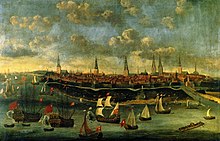
The Wapen von Hamburg undertook a total of eleven convoy trips from 1669 to 1683, which took them nine times to the Iberian Peninsula and once each to England and the Arctic Ocean .
Martin Holste was called up as captain in 1669 , who had previously made a name for himself in the escort mission with the largest Hamburg Tonnbojer and was able to buy into the new function.
However, Holste fell out of favor after he had partially violated or ignored the captain's order for his convoy trips with the Wapen of Hamburg . For example, he refused to escort some convoy ships, but instead remained in certain or unforeseen places longer in roadsteads than his captain's order stipulated, and sent the convoy cash desk excessive bills.
Since Holste was expected to follow the captain's order very strictly, but he did not stop his permissive action despite repeated admonitions, a committee finally dealt with the incidents in order to discipline him. As a result, Holste lost the responsibility for the Wapen von Hamburg , but remained due to influential relatives in the function of a captain, but without actively exercising his command on a convoy ship.
In 1683 major repairs were made to the sister ship Leopoldus Primus . Since the actual Captain Holste was in dispute with the Admiralty at that time, Admiral Berend Jacobsen Karpfanger , who had made a great contribution to Hamburg through numerous fights against the pirates, was spontaneously transferred from the Leopoldus Primus to the Wapen of Hamburg and transferred give him command of the ship. Karpfanger went on his first trip with the Wapen from Hamburg in autumn 1683 , which took him to Cádiz with a little delay in October 1683 . Here he went to the roadstead to make further travel preparations: The Isle of Wight in England was planned as a stage destination for the return journey , before returning to Hamburg.
At that time the ship was manned by 150 sailors and officers and 80 soldiers . Also on board were a Profos and his people, as well as some surgeons , a preacher , a few cooks and some servants .
The fire of 1683
In the evening hours of October 10, 1683, a fire broke out in the lowest room of the forecastle of the Wapen von Hamburg for unknown reasons. This expanded quickly and could no longer be adequately contained with on-board resources despite great efforts. The crew tried to get themselves to safety in sloops , but Karpfanger ordered them back to the fire to make further attempts to extinguish the fire . At the same time, signal shots were fired from the guns of the Wapen of Hamburg , which were supposed to signal the dispatch of auxiliary fire fighting teams to the surrounding ships. When the fire widened through the deck to the foremast and immediately ignited the rigging and sails due to an unfavorable wind , the rowing helpers remained at a safe distance for fear of an explosion . Karpfanger had his son who was traveling with him disembark, who had previously appealed to his father to leave the ship with him in order to bring both lives to safety. Karpfanger did not want to see the ship as lost yet. His officers suggested making a leak in the hull and filling the ship with water and placing it on the seabed - Karpfanger refused. Finally, he agreed to a Strandungsversuch to and let the ropes of the frigate caps, to set the ship close to the shore due. Leaving the ship was out of the question for Karpfanger anyway: he saw himself bound by his oath taken on July 14, 1674 before the Hamburg Senate , which imposed on him " to be manly in defending the entrusted fleet and rather good and blood, To sacrifice life and limb when leaving her and his ship ".
While the convoy drifted slowly towards the bank, the fire below deck moved more and more towards the stern . Around midnight it finally reached the individual guns, which ignited themselves and fired salvos by themselves ; At the same time, some of the artillery shells on board also detonated .
One hour after midnight, after the ship had burned for five hours and Admiral Karpfanger was still the last man on board, true to his oath, the fire below deck reached the powder chamber , which finally exploded. The rear part of the ship, which was broken in half, flew into the air, the front part lay on its side and began to sink. The debris rained down from a great height.
The accident resulted in 65 deaths: 22 soldiers and 42 boatmen as well as Admiral Karpfanger died. His body was found on October 11, 1683, floating in the water on an anchor line of an English ship in the port of Cádiz.
On the occasion of his funeral ceremonies, Karpfanger received appropriate condolences from the ships of various nations in the port: contemporary witnesses claim to have counted over 300 gun salutes .
After the loss of the ship
Although the repaired Leopoldus Primus was still available for use, the Admiralty considered a new building in 1685, since trading with two operational convoy ships could cover considerably more convoys - also on different routes - and thus generate more sales. The new building should be smaller than its predecessor Wapen from Hamburg (not least for reasons of cost) . The basis of the considerations was a smaller convoy ship with 30-40 cannons. In September 1685, the Hamburg citizenship approved 30,000 thalers and decided to build a new building. The successor Wapen von Hamburg (II) was completed in 1686, but still had similar dimensions and armament as its predecessor.
In total there were four convoy ships with the name Wapen von Hamburg , which worked for the city of Hamburg from 1669 to 1747 until the convoy escort by convoy ships was discontinued.
literature
- Kurt Grobecker: Hamburg's proud frigates against the corsairs - convoy ship (f) ahrt in the 17th century , Medien-Verlag Schubert, Hamburg, 2007, ISBN 978-3-937843-12-4
- Prof. Dr. Jörgen Bracker: Hamburg Portrait 1/76, Wapen von Hamburg (III)… a floating baroque palace ; Museum of Hamburg History, Dingwort Verlag Hamburg-Altona, 1976.
- Prof. Dr. Jörgen Bracker: God's friend - all over the world enemy / From piracy and convoy travel / Störtebeker and the consequences , Zertani printing and publishing house, Bremen, 2001, ISBN 3-9805772-5-2
- Wolfgang Quinger: "Coat of Arms of Hamburg" I. A 17th century convoy ship . Delius Klasing Vlg GmbH (1980), Hamburg, ISBN 3-7688-0329-5 , ISBN 978-3-7688-0329-8
- Werner von Melle: Karpfanger, Berend Jacobsen (1623-1683) Hamburg sea captain and admiral. Biographie , Allgemeine Deutsche Biographie Volume 15, published in 1882.
- Georg Dietrich von der Groeben : Explanations on understanding shipping and naval warfare according to alphabetical order , published in 1774, Breßlau. Reprint of the original edition: Neufahrn / Percha 1984, ISBN 3-88706-235-3
- Carlo M. Cipolla: Sails and cannons - The European expansion at sea , Berlin: Verlag Klaus Wagenbach, 1999. ISBN 3-8031-3602-4
- W. zu Mondfeld, A. Bayerlein, M. Klingenbrunn: Schiffsgeschützen 1350-1870 , Volume 1, Herford 1988.
- Herman Langenbeck: Notes on the Hamburg ship and sea law, published 1727, Hamburg.
- Klaus Weber: "German merchants in the Atlantic trade, 1680-1830, companies and families in Hamburg, Cádiz and Bordeaux", Verlag CH Beck oHG, Munich 2004, ISBN 3-406-51860-5
- Dr. Carl W. Reinhold, Georg Nikolaus Bärmann: "Hamburg Chronicle of the Origin of the City up to Our Days", Hamburg 1820
- Peter Hessel: "Heart-flowing considerations / From the Elbe river", Altona 1675.
- Come on, Ulrich: "Mit Breitseite and Enterbeil", Military Publishing House of the GDR, Berlin 1971
See also
- Wapen of Hamburg (II)
- Wapen of Hamburg (III)
- Wapen of Hamburg (IV)
- Admiralty of Hamburg
- The hope
- Leopoldus Primus
- Golden Lion (1689) (Bremen)
- Coat of arms of Bremen (Bremen)
- Friedrich Wilhelm on Horseback (Brandenburg-Prussia)
Web links
Footnotes
- ↑ In sources and secondary literature, some of the Hamburg convoy ships are sometimes referred to as frigates , even if the ships were relatively large two-deckers (that means two gun decks). But they were not frigates in the newer sense of the type of lighter, very seaworthy warships with only one gun deck introduced from the middle of the 18th century. In the 17th and first half of the 18th century the term "frigate" was used for a number of different types of ships, so that many ships from very small "single decks" to relatively large "double deckers" could be called this.
- ↑ Only the number of guns on the ship is known, not the caliber. The likely calibers were reconstructed after similar ships were armed.
- ↑ Some sources / literature and in modern parlance the ship also will coat of arms of Hamburg , in some older sources also Wapen Hamburg called; The spelling “Wapen” is therefore historically correct as shown.
- ↑ In June 1662, shortly before the Commerzdeputation was founded, eight armed Hamburg drivers and goods were captured from just two barbarian galleys . This hijacking ultimately caused economic damage of around 1.5 million Courantmarks for the Hamburg merchants.
- ↑ The city council occasionally referred to the ships in its writings as "Orlog" ships, meaning warships. The Admiralty as well as the merchants asserted externally that the ships would always serve the protection and defense of merchant goods and were not commissioned for acts of war in Hamburg.
- ↑ In the times when the ships were in Hamburg at roadstead and waiting for new convoy orders, some of the guns were brought into the convoy arsenal and used to defend the city on the city walls if necessary. Towards the end of the Hamburg convoy, however, the guns mostly remained on the ships, so that the entire ship could then be used as a floating battery / guard ship for port-side defense / security
- ↑ As quoted in: Wolfgang Quinger: "Wappen von Hamburg" I. A convoy ship of the 17th century. Delius Klasing Vlg GmbH (1980), Hamburg, ISBN 3-7688-0329-5 , ISBN 978-3-7688-0329- 8th
- ↑ In particular because of the good quality and good infrastructure for transporting Swedish artillery, the Hamburg Admiralty was prepared to accept longer transport routes. After initial quality deficiencies, Swedish cannons were successfully manufactured according to Dutch know-how, so that Sweden became one of the leading arms manufacturers in Europe from 1639 onwards. In 1668 a total of 1,346 cannons left the Swedish manufactories on the export route (to Mondfeld / Bayerlein / Klingenbrunn, p. 170 and Cipolla, p. 61 ff.)
- ↑ At that time it was common in Hamburg to buy into the role of captain. In addition to numerous advocates, the applicant had to have a not insignificant amount of money to be able to take up a position. A captain of a convoy ship was paid 150 thalers a month , so it took a certain amount of time before the work was amortized. The selection of the captains was made by the convoy college. A convoy ship captain received a fixed salary and pension for life.
- ↑ Some convoy ship captains transported goods themselves on the ships entrusted to them, which were not declared in any balance sheets, in order to then sell them profitably at the end of the voyage. In addition, they carried valuable goods (jewelry, silver, etc.) on behalf of third parties on the heavily armed convoy ships, as the transport on board these ships seemed very safe from enemy attacks. This transport also ran through no balance sheet. At the end of the voyage, the captain then received payment from his client for the transport. The Admiralty as well as the Commerzdeputation generally tolerated this procedure, but only until their own traders suffered disadvantages as a result and scheduled convoys reached their destinations significantly late or some merchant ships could no longer join the convoy due to the unplanned delays.
